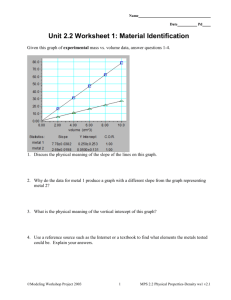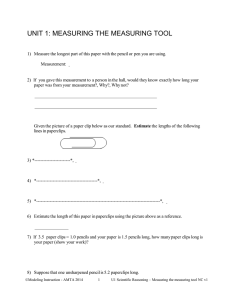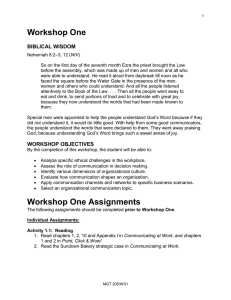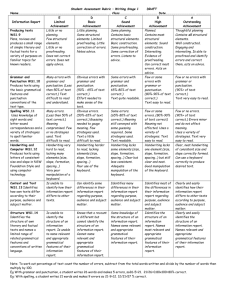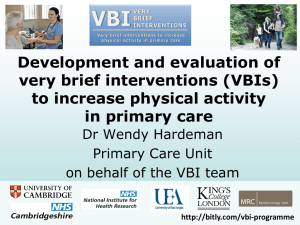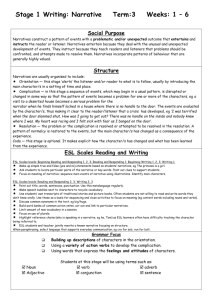Alignment Between the PREPaRE School Crisis Training Curriculum and
advertisement
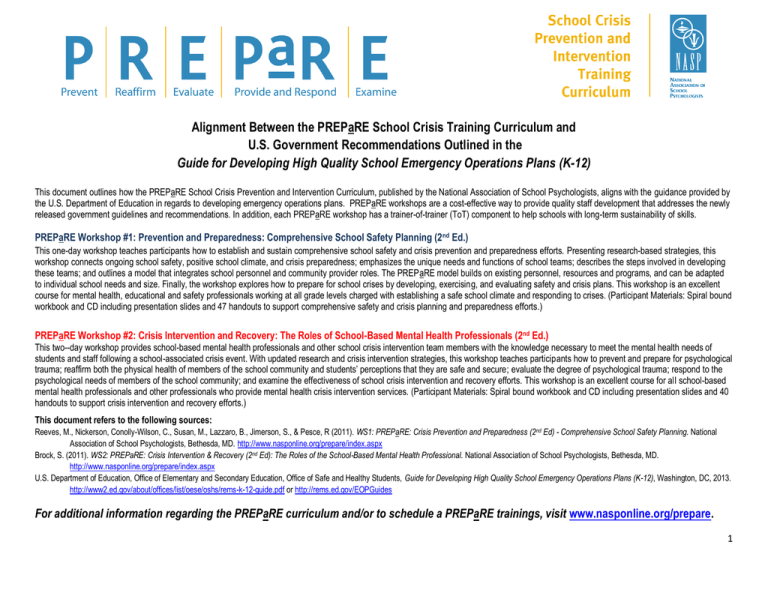
Alignment Between the PREPaRE School Crisis Training Curriculum and U.S. Government Recommendations Outlined in the Guide for Developing High Quality School Emergency Operations Plans (K-12) This document outlines how the PREPaRE School Crisis Prevention and Intervention Curriculum, published by the National Association of School Psychologists, aligns with the guidance provided by the U.S. Department of Education in regards to developing emergency operations plans. PREPaRE workshops are a cost-effective way to provide quality staff development that addresses the newly released government guidelines and recommendations. In addition, each PREPaRE workshop has a trainer-of-trainer (ToT) component to help schools with long-term sustainability of skills. PREPaRE Workshop #1: Prevention and Preparedness: Comprehensive School Safety Planning (2nd Ed.) This one-day workshop teaches participants how to establish and sustain comprehensive school safety and crisis prevention and preparedness efforts. Presenting research-based strategies, this workshop connects ongoing school safety, positive school climate, and crisis preparedness; emphasizes the unique needs and functions of school teams; describes the steps involved in developing these teams; and outlines a model that integrates school personnel and community provider roles. The PREPaRE model builds on existing personnel, resources and programs, and can be adapted to individual school needs and size. Finally, the workshop explores how to prepare for school crises by developing, exercising, and evaluating safety and crisis plans. This workshop is an excellent course for mental health, educational and safety professionals working at all grade levels charged with establishing a safe school climate and responding to crises. (Participant Materials: Spiral bound workbook and CD including presentation slides and 47 handouts to support comprehensive safety and crisis planning and preparedness efforts.) PREPaRE Workshop #2: Crisis Intervention and Recovery: The Roles of School-Based Mental Health Professionals (2nd Ed.) This two--day workshop provides school-based mental health professionals and other school crisis intervention team members with the knowledge necessary to meet the mental health needs of students and staff following a school-associated crisis event. With updated research and crisis intervention strategies, this workshop teaches participants how to prevent and prepare for psychological trauma; reaffirm both the physical health of members of the school community and students’ perceptions that they are safe and secure; evaluate the degree of psychological trauma; respond to the psychological needs of members of the school community; and examine the effectiveness of school crisis intervention and recovery efforts. This workshop is an excellent course for all school-based mental health professionals and other professionals who provide mental health crisis intervention services. (Participant Materials: Spiral bound workbook and CD including presentation slides and 40 handouts to support crisis intervention and recovery efforts.) This document refers to the following sources: Reeves, M., Nickerson, Conolly-Wilson, C., Susan, M., Lazzaro, B., Jimerson, S., & Pesce, R (2011). WS1: PREPaRE: Crisis Prevention and Preparedness (2nd Ed) - Comprehensive School Safety Planning. National Association of School Psychologists, Bethesda, MD. http://www.nasponline.org/prepare/index.aspx Brock, S. (2011). WS2: PREPaRE: Crisis Intervention & Recovery (2nd Ed): The Roles of the School-Based Mental Health Professional. National Association of School Psychologists, Bethesda, MD. http://www.nasponline.org/prepare/index.aspx U.S. Department of Education, Office of Elementary and Secondary Education, Office of Safe and Healthy Students, Guide for Developing High Quality School Emergency Operations Plans (K-12), Washington, DC, 2013. http://www2.ed.gov/about/offices/list/oese/oshs/rems-k-12-guide.pdf or http://rems.ed.gov/EOPGuides For additional information regarding the PREPaRE curriculum and/or to schedule a PREPaRE trainings, visit www.nasponline.org/prepare. 1 At-A-Glance Comparison of Content Covered in A Guide for Developing High Quality School Emergency Operations Plans (K-12) and PREPaRE Crisis Prevention & Intervention Curriculum Guide for Developing High Quality School P R E P a R E Emergency Operations Plans (K-12) Introduction and Purpose Planning Principles The Planning Process 1. Form a Collaborative Planning Team 2. Understand the Situation 3. Determine Goals and Objectives 4. Plan Development 5. Plan Preparation, Review, and Approval 6. Plan Implementation and Maintenance Plan Content The Basic Plan Functional Annexes Content Threat-and Hazard Specific Annexes Prevent Reaffirm Evaluate Provide and Respond Examine WS1: Prevention and Preparedness: Comprehensive School Safety Planning Alignment across all phases of crisis management M--PHAT Approach(Multi-Phase, Hazard, Agency, and Tiered) Addressing physical and psychological safety WS1: Prevention and Preparedness: Comprehensive School Safety Planning Plan importance and guiding principles o Comprehensive Safety Plan - Purpose and Goals o Crisis Plans – Importance, Development, Implementation WS1: Prevention and Preparedness: Comprehensive School Safety Planning Examination Strategies – Needs Assessment, Process Assessment, Outcome Evaluation Forming Collaborative Safety Teams Vulnerability Assessments – Physical and Psychological safety, Threat and Suicide Assessments Using data to identify immediate priorities Comprehensive Safety Plan-Purpose and Goals School Emergency Protocols and Drills Cultural and Special Needs Considerations Continuity of Operations Plan Exercising and Evaluating Plans School Crisis Plan Development and Implementation Alignment with the Incident Command System Crisis Team Response Plans and Components Evacuation, Accountability, Communication, Reunification Mini-Plans Crime Prevention Through Environmental Design Positive/Safe School Climate, Developing School Resilience and School Connectedness, Establishing Safe Schools Threat Assessment and Suicide Risk Assessment WS2: Crisis Intervention and Recovery: The Roles of School Based Mental Health Professionals Evaluate Psychological Trauma Risk o Assessment Variables: Crisis Exposure, Personal Vulnerabilities, Threat Perceptions, Crisis Reactions, Developmental and Cultural Variations o Relationships between Psychological Triage & Crisis Interventions Levels of Crisis Interventions – Universal, Selected, and Indicated (short and long-term) o Naturally Occurring Support Systems, Classroom/Group-Based and Individual Crisis Intervention Protocols, Psychotherapeutic Interventions. Care for the Caregiver 2 DETAILED COMPARISON PREPaRE Curriculum Key Concepts/Guidelines from Guide for Developing High Quality School Emergency Operations Plans (K-12) Concept/Guidelines Page # Indicates WS1: Crisis Prevention & Preparedness Workshop Content Indicates WS2: Crisis Intervention & Recovery Workshop Content PREPaRE Concepts and Language That Address U.S. Dept. of Ed concept/guidelines Workshop ppt slide # INTRODUCTION & PURPOSE Presidential Policy Directive 8 (PPD 8) 1-3 WS1: Phases of Crisis Management 16-18 24 PLANNING PRINCIPLES 4 WS2: Relationship Between Phases of a Crisis, the PREPaRE Model and Levels of Prevention WS1: Plan Importance and Guiding Principles THE PLANNING PROCESS 5-23 WS1: Examination Strategies: Needs Assessment, Process Analysis and Outcome Evaluation 91 48-49; 66-69 WS2: Examination Strategies: needs assessment, process analysis and outcome evaluation Step 1: Forming a Collaborative Team 5 WS1: Safety Teams (referred to as Planning Teams in gov. guide) 44-47 Step 2: Understand the Situation 7 38; 51-52 Step 3: Determine the Goals and Objectives 12 WS1: Vulnerability Assessment addressing both physical and psychological safety; threat and suicide assessment WS1: Using vulnerability assessment data, identify most immediate priorities to address WS1: Comprehensive Safety and Crisis Plan Goals Step 4: Plan Development (Identifying Courses of Action) 14 WS1: Emergency Protocols & Emergency Drills and Exercises WS1: Cultural Considerations & Special Needs Consideration 51-52 49, 68 71-72 83-85 Workshop Handouts/Resources (H#) WS2-H4: Relationship Between Phases of a Crisis, the PREPaRE Model and Levels of Prevention (WS2) WS1-H 4: Comprehensive School Safety Plan Checklist WS1-H5: Model of Comprehensive Safety Plan WS1-H 33: Guiding Principles for Plan Development WS1-H 34: Planning Questionnaires for Schools WS1-H22: Evaluating Crisis Plan Preparedness (Needs Assessment) WS1-H 45: Checklist: Evaluating the Crisis Response (Process Analysis) WS1-H 46: Examining Immediate Response and Longer-Term Recovery Efforts (Outcome Evaluation) WS2: Process Analysis WS2-H 33: Questionnaire WS2-H34: Interview Questions WS2: Outcome Evaluation WS2-H35 & H36: Crisis Response Outcomes WS2-H37: Evaluation Questionnaire WS2-H38: Teacher Survey WS1-H 2: District Safety Team Core Functions & Members WS1-H 3: School Safety Team Core Functions & Members WS1-H 31: Advocacy Tips for School Personnel for Crisis Planning WS1-H6: School Building Vulnerability Assessment WS1-H 28 & H29: Suicide and Threat Assessment WS1-H 6 Vulnerability Assessment activity WS1-H4: Comprehensive School Safety Plan Checklist WS1-H 33: Guiding Principles for Plan Development WS1-H 34: Planning Questionnaires for Schools WS1-H 13: Emergency Protocols, Drills, Exercises, and Procedures WS1-H 35 School Emergency Protocol Exercises and Drills Supplemental handout: Conducting Crisis Exercises and Drills: Guidelines for Schools http://www.nasponline.org/resources/crisis_safety/drills_guidance.pdf 3 Step 5: Plan Preparation, Review, and Approval 16 WS1: Comprehensive Safety Plans 48-50 WS1-H 4: Comprehensive School Safety Plan Checklist WS1: Crisis Response Plans 75-80 WS1-H 14: Crisis Team Response Plan Components WS1-H 15: Essential Elements of a Release and Reunification Plan WS1-H 16: Crisis Team/Administrator Emergency Response Go-Kit WS1-H 17: School Staff Response Plan Components WS1-H 37: Classroom Go-Kit WS1-H 38: Mental Health Response Team Go-Kit WS1-H 39: Essential Elements of a Communication Plan WS1-H 40: Sample MOU WS1-H 41: Readiness and Emergency Management Preparedness Template WS1-H 42: Sample Crisis Intervention Team Manual WS1-H 43: Illinois Crisis Plan Template WS1-H 44: Levels of Crisis Interventions Step 6: Plan Implementation and Maintenance 20 WS1: Continuity of Operations Plan (COOP) WS1: Exercising and Evaluating Plans 76 70-74 PLAN CONTENT 23-36 WS1: Crisis Plans 65-80 WS1-H 36: Sample COOP WS1-H 13: Emergency Protocols, Drills, Exercises, and Procedures WS1-H 35: School Emergency Protocol Exercises and Drills WS1-H 41:Readiness and Emergency Management Preparedness Template WS1-H: 13-17 (see above) WS1-H: 33-44 (see above) The Basic Plan: Introductory Material, Purpose and Situation Overview, Concept of Operations Organization and Assignment of Responsibilities 23-25 WS1: Crisis Plans (Legislation, Importance) 65-66 25-26 WS1 Guiding Principles: Plan Development and Implementation 68-69 WS1-H 33: Guiding Principles for Plan Development WS1-H 34: Planning Questionnaires for Schools WS1: Incident Command Structure (ICS) 54-62 WS1: School Crisis Plan 70,72,80 WS1-H 7: School Incident Command Structure WS1-H 8: School Incident Command Structure Roles and Responsibilities WS1-H 9: Essential Duties of ICS Members Serving on Safety Teams WS1-H 10: Operations Section of ICS WS1-H 17: School Staff Response Plan Components WS1-H 35: School Emergency Drills and Exercises WS1: Incident Command Structure (ICS) WS1: Exercising and Evaluating Plans WS1: School Emergency Drills and Exercises WS1: Incident Command Structure (ICS) WS1: COOP WS1: Exercising and Evaluating Plans WS1: Planning and Preparedness Components 54-62 70, 72-74 WS1-H 7-10 (see above) WS1-H 35: School Emergency Protocol Exercises and Drills 54-62 76 70, 76, 78 WS1-H 7-10 (see above) WS1-H 36: Sample COOP WS1-H 14: Crisis Team Response Plan Components WS1-H 36: Sample COOP Direction, Control, and Coordination; Information Collection, Analysis and Dissemination 26 Training and Exercises 27 Administration, Finance, and Logistics Plan Development and Maintenance 27 27-28 4 Gov’t uses the term “annex”; WS1 uses the term “mini-plan” both are speaking of the same concept: annex=mini-plan Functional Annexes Content Evacuation Annex 28 WS1: Evacuation Mini-Plan 76 Lockdown Annex 29 WS1: Emergency Protocols 71, 76 Shelter-in Place Annex Accounting for All Person Annex 29-30 30 WS1: Emergency Protocols WS1: Accountability Mini-Plan 71 76 Communications and Warning Annex Family Reunification Annex Continuity of Operations (COOP) Annex Recovery Annex 30 WS1: Communications Mini-Plan 76 WS1-H 14: Crisis Team Response Plan Components WS1-H 36: Sample COOP WS1-H 13: Emergency Protocols, Drills, Exercises, and Procedures WS1-H 14: Crisis Team Response Plan Components WS1-H 36: Sample COOP WS1-H 13: Emergency Protocols, Drills, Exercises, and Procedures WS1-H 14: Crisis Team Response Plan Components WS1-H 15: Essential Elements of a Release and Reunification Plan WS1-H 36: Sample COOP WS1-H 39: Essential Elements of A Communication Plan 31 32-33 WS1: Reunification Mini-Plan WS1: COOP 76 76 WS1-H 15: Essential Elements of a Release and Reunification Plan WS1-H 36: Sample COOP 33 WS1: Recovery Plan 78 WS1-H 44: Levels of Crisis Interventions Public Health, Medical, and Mental Health Annex Security Annex 34 Threat –and Hazard Specific Annexes 35-36 A CLOSER LOOK Information Sharing FERPA HIPPA Psychological First Aid for Schools (PFA-S) Training School Staff 35 WS2: Provide Interventions and Respond to Psychological Needs WS1: Collaboration WS1: Memorandum of Understanding WS1: CPTED (Crime Prevention Through Environmental Design) WS1: Overview of School Crisis Models WS1: Comprehensive Safety Teams and Plans WS1: Using vulnerability assessment data, identify most immediate priorities to address 39-40 77 22-29 18, 50 38;51-52, WS2-H 17: Relationships Between Psychological Triage and Crisis Interventions WS1-H 40: Sample MOU WS1-H 5: Model of a Comprehensive Safety Plan WS1-H 6: School Building Vulnerability Assessment WS1-H 13: Emergency Protocols, Drills, Exercises, and Procedures 37-67 39-50 51-52 52-53 WS1: Crisis Plan Legislation WS1: Crisis Plan Legislation WS2: Assessment Variables: Crisis Exposure, Personal Vulnerabilities, Threat Perceptions, Crisis Reactions, Developmental and Cultural Variations WS2: Evaluate Psychological Trauma Risk WS2: Provide Interventions and Respond to Psychological Needs 65 65 43-65 44-48; 52; 54-64; 6869; 71-76 85-120; 122- 146; 153-158 WS2-H 6: Identifying and Responding to Emotionally Overwhelmed Students WS2-H 7: Personal Vulnerability to Psychological Trauma Subsequent to Crisis Event Exposure WS2-H 8: Warning Signs of Traumatic Stress WS2-H 9: Psychological Trauma Risk Checklist WS2-H 10: Conducting Psychological Triage: Levels of Triage WS2-H 11: Private Practitioner Referral Questionnaire WS2-H 12: Primary Risk Screening WS2-H 13: School Crisis Intervention Referral Form WS2-H 14: Traumatic Stress Screening Tools WS2-H 15: Psychological Triage Summary Tool 5 WS2-H 17: Relationships Between Psychological Triage and Crisis Interventions WS2-H 18: Levels of School Crisis Interventions WS2-H 19: Sample Psychoeducational Information Document WS2-H 20: Links to Guidance on Responding to Children’s Crisis Reactions WS2-H 21: Sample Classroom Meeting Script & Outline WS2-H 22: Stress Management Resources and Adaptive Coping Strategies WS2-H 23: Lesson Plan for Use When Conducting Student Psychoeducational Group WS2-H 24: Passive Consent Form Template for Classroom Crisis Intervention WS2-H 25: Elements of Individual Crisis Intervention WS2-H 26: Delivery of Individual Crisis Intervention WS2-H 27: Suggestions for Stabilizing the Emotionally Overwhelmed Student WS2-H 28: Possible Questions to Ask When Identifying Crisis Problems WS2-H 29: Possible Questions to Ask When Assessing Lethality School Climate and Emergencies Conduct Comprehensive Needs Assessment Use Multi-Tiered Interventions and Supports Promote Social and Emotional Competencies Active Shooter Situations Planning and Sharing Info with First Responders 53-55 55 55-56 WS1: Crisis Preparedness – Comprehensive Safety Teams and Plans WS1: School Safety and Crisis Prevention – Psychological Safety 44-52 56 WS1: School Safety and Crisis Prevention – Psychological Safety to include: Positive Behavior Supports, Social-Emotional Learning, School Connectedness, Resiliency, Selecting Prevention Programs, Strategies to improve climate, safety, and resilience WS1: Emergency Protocols & Emergency Drills and Exercises 31-38 71-72 WS1-H 13: Emergency Protocols, Drills, Exercises, and Procedures WS1-H 5: School Emergency Protocol Exercises and Drills WS1: Comprehensive Safety Plans 48-50 WS1-H 4: Comprehensive School Safety Plan Checklist WS1: Crisis Response Plans 75-80 WS1: Continuity of Operations Plan (COOP) 76 WS1-H 14: Crisis Team Response Plan Checklist WS1-H 36: Sample COOP WS1: Collaboration 39-40 57-58 31-38 WS1-H 4 Comprehensive School Safety Plan Checklist, WS1-H 6 School Building Vulnerability Assessment WS1-H 26: Relationship Between Mental Health and Academic Achievement WS1-H 27: Establish Safe Schools WS1-H 25: Components of a Positive/Safe School Climate WS1-H 1: Developing School Resilience and School Connectedness WS1-H 26: Relationship Between Mental Health and Academic Achievement WS1-H 27: Resources for Establishing Safe Schools WS1-H 30: Local, State, and National Collaborative Partners and Resources 6 Exercises 58 WS1: Emergency Protocols & Emergency Drills and Exercises 71-72 WS1-H 13: Emergency Protocols, Drills, Exercises, and Procedures Supplemental handout titled: Conducting Crisis Exercises and Drills: Guidelines for Schools http://www.nasponline.org/resources/crisis_safety/drills_guidance.pdf Preventing an Active Shooter Situation 59-61 WS1: CPTED (Crime Prevention Through Environmental Design) 22-29 WS1: School Safety and Crisis Prevention – Physical Safety WS1: School Safety and Crisis Prevention – Psychological Safety WS1: School Safety and Crisis Prevention – Psychological Safety 38 WS1-H 28: Suicide Risk Assessment WS1-H 29: Threat Assessment 38 WS1-H 28: Suicide Risk Assessment WS1-H 29: Threat Assessment Threat Assessment Teams 62-63 Responding to an Active Shooter Situation 63-66 WS1: Emergency Protocols & Emergency Drills and Exercises 71-72 WS1-H 13: Emergency Protocols, Drills, Exercises, and Procedures Interacting with First Responders 66 WS1: Incident Command Structure (ICS) WS1: Level of Response and ICS Roles Activity WS1: Collaboration 54-62 63 39-40 WS1-H 12: Level of Response and ICS Roles Activity Worksheet WS1-H 30: Local, State, and National Collaborative Partners and Resources After an Active Shooter Incident 66-67 WS1: Crisis Teams and Plans WS1: Special Considerations 54-64; 75-80 83-88 Unique Content in Dept of Ed Guidance Topics NOT Covered in PREPaRE WS1 which are covered by gov’t guidelines: A distinctly sequential approach to the Planning Process Unique Content in PREPaRE Topics Covered in PREPaRE WS1 NOT covered by gov’t guidelines: Basic Assumptions: crisis theory & crisis event characteristics Strong emphasis on balancing physical and psychological safety How to manage technology and use to help with information dissemination and psychological triage Communicating with the Media Memorials Topics Covered in PREPaRE WS2 NOT covered by gov’t guidelines: Basic Assumptions: crisis theory & crisis event characteristics Crisis variables Strong emphasis on balancing physical and psychological safety Conducting psychological triage Providing a multi-tiered level of interventions based upon demonstrated need Care-for-the-caregiver Providing and teaching a specific protocols to follow regarding crisis intervention (it is NOT a one-size fits all approach to response) 2013 National Association of School Psychologists, 4340 East West Highway, Suite 402, Bethesda, MD 20814, 301-657-0270 www.nasponline.org 7 updated 9/7/14
